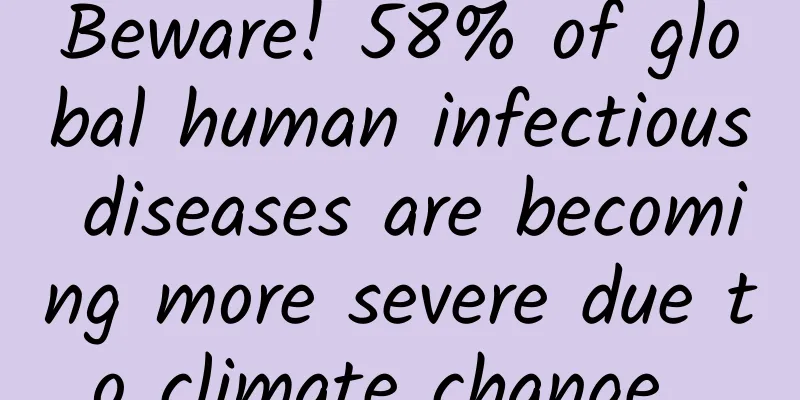Beware! 58% of global human infectious diseases are becoming more severe due to climate change…

|
The global disaster caused by the COVID-19 pandemic has clearly demonstrated that humans are often quite vulnerable to pathogenic diseases. As of August 7, 584,595,723 people have been diagnosed with COVID-19 worldwide, and 6,418,093 patients have died due to ineffective treatment. In addition, the broader socioeconomic consequences caused by the COVID-19 pandemic have also brought heavy disasters to the world, and this catastrophic impact is far from over. Humanity should also note that the COVID-19 pandemic is not an isolated event. Every year, millions of people around the world die from HIV, Zika, malaria, dengue, chikungunya, influenza, Ebola, MERS, SARS, etc., and many more “survivors” suffer incalculable pain. Humanity is reaping the fruits of its own actions. A new study shows that 277 human pathogenic diseases are likely to be aggravated by a wide range of climate disasters caused by continued human emissions of greenhouse gases (GHGs), including 58% of the infectious diseases known to have affected humans on record. Furthermore, a range of climate hazards can cause disease outbreaks through a taxonomic diversity of pathogens in more than 1,000 different pathways with different transmission types. The related research paper, titled “Over half of known human pathogenic diseases can be aggravated by climate change”, has been published in the authoritative scientific journal Nature Climate Change. The research team said that **these findings highlight further human health risks under continued climate change. **Because the number and transmission pathways of human pathogenic diseases exacerbated by climate disasters are too large, humans are no longer able to make comprehensive social adaptations, so there is an urgent need to start from the root of the problem: reducing greenhouse gas emissions. It is widely accepted that climate change can affect human pathogenic diseases. On the one hand , people are increasingly aware that greenhouse gas emissions affect a variety of climate hazards in the Earth system (such as global warming, heat waves, droughts, wildfires, extreme precipitation, floods, sea level rise, etc.). Large amounts of greenhouse gases can cause global warming, increasing the air's ability to retain moisture, thereby accelerating the evaporation of moisture in the soil, leading to droughts, which in turn lead to heat waves, and droughts and heat waves provide conditions for wildfires; heavy precipitation may cause floods, and ocean warming and sea level rise increase the intensity of heavy rains and storms, which in turn cause floods; carbon dioxide can cause seawater to become acidic, and ocean circulation and warming seawater reduce the oxygen concentration in seawater. Figure | Climate disasters in the Earth system affected by continued greenhouse gas emissions. On the other hand , the human pathogenic diseases (from bacteria, viruses, animals, plants, fungi, protozoa, etc.) and transmission types (vector-borne, airborne, direct contact, etc.) affected by these climate disasters are widely diverse in classification. Climate disasters weaken humanity’s ability to cope with pathogens by changing the human physical condition, increasing human exposure to hazardous environments, forcing humans into unsafe environments, damaging infrastructure, forcing humans into passive exposure to pathogens, and reducing human access to health care. Moreover, widespread impacts of climate disasters on terrestrial and marine food supplies, and reduced nutrient concentrations in crops under high CO2 conditions, can directly lead to human malnutrition, which is one of the reasons why food-insecure populations are at greater risk of disease outbreaks (such as cryptosporidiosis, measles and cholera). In some cases, droughts can reduce drinking water supplies, forcing people to drink unsafe water, causing outbreaks of diarrhea, cholera, and dysentery. Reduced water resources also lead to poor sanitation, leading to trachoma, chlamydia, cholera, conjunctivitis, cryptosporidium, diarrheal diseases, dysentery, E. coli, giardia, salmonella, scabies, and typhoid. Climate hazards also affect disease risks by damaging critical infrastructure. For example, damaged sewage systems and drinking water disruptions caused by floods, heavy rains, and storms have been associated with outbreaks of cholera, diarrhea, hepatitis A, hepatitis E, leptospirosis, acanthamoeba keratitis, cryptosporidiosis, cyclosporiasis, giardiasis, rotavirus, dysentery, and typhoid. By reducing access to health care, basic supplies, and reducing income, these hazards have also been associated with outbreaks of gonorrhea and other sexually transmitted diseases. However, past studies on the impact of climate hazards on human pathogenic diseases, with a few exceptions, have generally focused on specific categories of pathogens (e.g., bacteria, viruses), hazards (e.g., global warming, extreme precipitation, floods), or transmission types (e.g., vector, food, water). Due to the failure to integrate existing information, it is impossible to quantify the full threat posed by climate change and pathogenic diseases to humans. In this work, the research team combined numerous climate disasters with numerous pathogens, revealing a large number of potential interactions by which climate disasters may exacerbate human pathogenic diseases. The research team systematically studied the impact of 10 climate hazards that are sensitive to greenhouse gas (GHG) emissions on each known human disease. As shown in the figure, climate disasters lead to the aggravation of specific pathogenic diseases through specific transmission types. The thickness of the line is proportional to the number of unique pathogenic diseases, and the color gradient represents the proportion of the number of diseases. Darker colors represent more numbers, and lighter colors represent fewer numbers. The number at each node represents the number of unique pathogenic diseases. Figure | Pathogenic diseases aggravated by climate disasters The research team systematically screened the literature and found 3,213 empirical cases linking 286 unique human pathogenic diseases to 10 climate disasters (such as warming, floods or droughts). Among them, 277 were exacerbated by at least one climate disaster, and only 9 were weakened by climate disasters. Overall, 58% of the list of infectious diseases that have been reliably documented to affect humans, or 218 of 375, have been shown to be exacerbated by climate change. Some hazards bring people closer to pathogens, such as displacement caused by storms or floods, which has been linked to Lassa fever and Legionnaires’ disease, while others bring pathogens closer to people, such as warming increasing the areas where organisms that transmit diseases such as Lyme disease, dengue fever and malaria are more active. The study also found that while most diseases are exacerbated by climate disasters, some diseases are alleviated by climate disasters (63 out of 286). For example, a warming climate appears to reduce the spread of viral diseases such as influenza, SARS, COVID-19, rotavirus, and norovirus enteritis, which could be related to creating conditions in which the viruses are less suitable for survival or because the human immune system is stronger in warmer conditions. Figure|Diseases affected by climate disasters However, the study also found that most diseases, when reduced by at least one hazard, were sometimes exacerbated by another or even the same hazard. For example, in some cases, flooding reduced infection with schistosomiasis by limiting habitat suitability for snail hosts. However, in other cases, flooding increased human exposure and expanded the range of hosts. Droughts also reduced the prevalence of malaria and chikungunya by reducing breeding sites, but in other areas, drought shortages led to increased mosquito densities in water-scarce areas. Humans are born in nature and have the responsibility to protect it. How can humans repair their relationship with nature? What do you think about this? Reference Links: https://www.nature.com/articles/s41558-022-01426-1 |
>>: Controlling sugar does not mean quitting sugar, the real sugar control manual is here!
Recommend
This year's Nobel Prize in Chemistry is finally not a science award!
This article was first published by Hunzhi (WeCha...
Why is altitude sickness fatal?
Why do people need oxygen? If oxygen inhalation i...
WeChat Speaking Skills Mini Program Function, How much does it cost to develop a Chat Talk Mini Program?
Some time ago, a customer consulted the editor and...
Why are 5G phones not selling as well as 2G phones in China?
Recently, the China Academy of Information and Co...
Why is it difficult to develop domestic chips? What are 7nm chips?
=========================================...
What's going on with the golden monkeys in Yunnan, Guizhou and Sichuan?
The golden snub-nosed monkey is a very famous rar...
Fireflies, the neglected revelation
A blue ghost firefly (Phausis reticulata) leaves ...
How to do foreign trade promotion: Google bidding promotion or Google optimization?
From the moment you decide to do Google foreign t...
Qualcomm and Google jointly announced new technology: Android R can replace ID cards and driver's licenses
[[284872]] Android Q (Android 10) has been releas...
How to use AED and seize the golden 4 minutes of "sudden death rescue"?
On the evening of June 30, a young athlete from t...
A great migration in the sky
“No migratory bird flies in a straight line” This...
The best electric cars are not up to standard when they leave the factory? Tesla employees say more than 90% of Model S/X have repair problems
When talking about the best electric car in the w...
3 tips to improve your product conversion effect!
We can actually use product conversion rate to me...
In 2020, the mobile phone giant will be reinstalled and "launched"
In the spring of 2020, the online channels of the...









